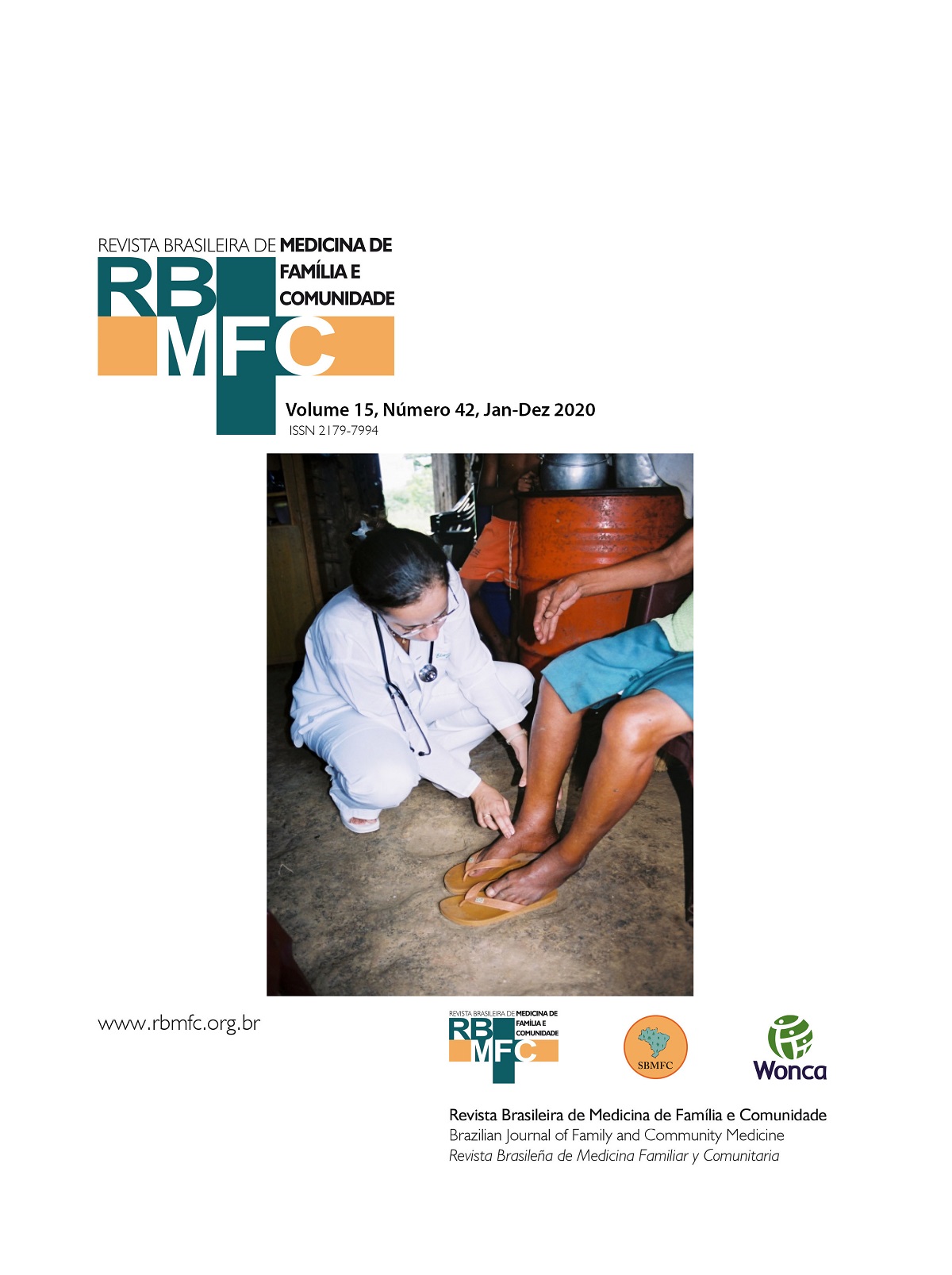Functional capacity and risk of falls in the elderly with metabolic syndrome
DOI:
https://doi.org/10.5712/rbmfc15(42)2228Keywords:
Metabolic Syndrome, Aging, Functionality and Falls.Abstract
Introduction: Metabolic syndrome (MetS) is the most common metabolic abnormality in the population that predisposes to cardiovascular events and may be related to poor physical fitness and low functional capacity in the elderly. The objective of this study was to evaluate the interference of metabolic changes in functional capacity and risk of falls in the elderly. Methods: A cross-sectional study was carried out with 126 elderly subjects, 58 presented MetS and 68 without MetS, according to the criteria of the International Diabetes Federation. Katz Index, Tinetti Index, Timed Up and Go test and Berg Scale were applied to evaluate the functional capacity. Falls Efficacy Scale-International scale (FES-I-Brazil) was used to evaluate the fear of falling. For statistical analysis, the Mann-Whitney, Chi-square and Spearman correlation tests were used. Results: There was an association between the MetS and non-MetS groups in relation to the risk strata of the TUG index [p=0.02; OR=0.38; 95%CI (0.16-0.91)]. Between these two groups, there was a significant difference in the mean of the following markers: Berg scale (p=0.03); TUG (p=0.03); FES-I-Brazil (p=0.02). The Kats and IPAQ index did not show any significant association. Conclusions: Elderly patients with MetS presented higher risk and fear of falls when compared to patients without MetS. However, there was no variation in walking ability or balance.
Downloads
Metrics
References
(1) Lam DW, Leroith D. Metabolic syndrome. In: Feingold KR, Anawalt B, Boyce A, et al., eds. Endotext. South Dartmouth, MA: MDText.com, Inc.; 2000.
(2) Peterson MD, Al Snih S, Stoddard J, Shekar A, Hurvitz EA. Obesity misclassification and the metabolic syndrome in adults with functional mobility impairments: nutrition examination survey 2003-2006. Prev Med. 2014 Mar;60:71-6. DOI: https://doi.org/10.1016/j.ypmed.2013.12.014
(3) Luedy A, Barreto DL, Costa-Ribeiro Júnior H. Impact of metabolic-syndrome risk factors on the absenteeism of health workers from a Brazilian University Hospital. Health. 2018 Jun;10(6):853-77. DOI: https://doi.org/10.4236/health.2018.106064
(4) Dominguez LJ, Barbagallo M. The biology of the metabolic syndrome and aging. Curr Opin Clin Nutr Metab Care. 2016 Jan;19(1):5-11. DOI: https://doi.org/10.1097/MCO.0000000000000243
(5) Cvecka J, Tirpakova V, Sedliak M, Kern H, Mayr W, Hamar D. Physical activity in elderly. Eur J Transl Myol. 2015 Aug;25(4):249-52. DOI: https://doi.org/10.4081/ejtm.2015.5280
(6) Soares RR, Rocha KO, Salgado PO, Lima LM. Functional capacity and risk of falls in the elderly with metabolic syndrome - database. Zenodo. 2020 Mar 30; [Epub ahead of print]. DOI: https://doi.org/10.5281/zenodo.3733531
(7) International Diabetes Federation (IDF). IDF consensus worldwide definition of the metabolic syndrome [Internet]. Brussels: IDF; 2006; [access in 2017 Jul 26]. Available from: https://www.idf.org/e-library/consensus-statements/60-idfconsensus-worldwide-definitionof-the-metabolic-syndrome.html
(8) International Society for the Advancement of Kinanthropometry (ISAK). International standards for anthropometric assessment. Lower Hutt, New Zealand: ISAK; 2011.
(9) Pardini R, Matsudo SMM, Matsudo VKR, Araújo T, Andrade E, Braggion GF, et al. Validation of international physical activity questionnaire (IPAQ): pilot study in Brazilian young adults. Med Sci Sports Exerc. 1997;29(6):5-9.
(10) Podsiadlo D, Richardson S. The timed “Up & Go”: a test of basic functional mobility for frail elderly persons. J Am Geriatr Soc. 1991 Feb;39(2):142-8. DOI: https://doi.org/10.1111/j.1532-5415.1991.tb01616.x
(11) Katz S, Ford AB, Moskowitz RW, Jackson BA, Jaffe MW. Studies of illness in the aged. The index of ADL: a standardized measure of biological and psychosocial function. JAMA. 1963 Sep;185(12):914-9. DOI: https://doi.org/10.1001/jama.1963.03060120024016
(12) Tinetti ME. Performance oriented assessment of mobility problems in elderly patients. J Am Geriatr Soc. 1986 Feb;34(2):119-26. DOI: https://doi.org/10.1111/j.1532-5415.1986.tb05480.x
(13) Berg KO, Wood-Dauphinee SL, Williams JI, Maki B. Measuring balance in the elderly: validation of an instrument. Can J Public Health. 1992 Jul/Aug;83(Suppl 2):S7-S11.
(14) Yardley L, Beyer N, Hauer K, Kempen G, Piot-Ziegler C, Todd C. Development and initial validation of the falls Efficacy Scale-International (FES-I). Age Ageing. 2005 Nov;34(6):614-9. DOI: https://doi.org/10.1093/ageing/afi196
(15) Hulley SB, Cummings SR. Estimating sample size and power. In: Designing clinical research. Philadelphia: Lippincott Williams and Wilkins; 1988. p. 148.
(16) Barr KP. Electrodiagnosis in the patient with metabolic syndrome: adding value to patient care. Phys Med Rehabil Clin N Am. 2018 Nov;29(4):735-49. DOI: https://doi.org/10.1016/j.pmr.2018.06.008
(17) Lord SR, Delbaere K, Sturnieks DL. Aging. Handb Clin Neurol. 2018;159:157-71. DOI: https://doi.org/10.1016/B978-0-444-63916-5.00010-0
(18) Cuevas-Trisan R. Balance problems and fall risks in the elderly. Clin Geriatr Med. 2019 May;35(2):173-83. DOI: https://doi.org/10.1016/j.cger.2019.01.008
(19) Bittar RSM, Santos MDA, Mezzalira R. Glucose metabolism disorders and vestibular manifestations: evaluation through computerized dynamic posturography. Braz J Otorhinolaryngol. 2016 Jul/Aug;82(4):372-6. DOI: https://doi.org/10.1016/j.bjorl.2015.10.005
(20) Thiamwong L, Suwanno J. Fear of falling and related factors in a community-based study of people 60 years and older in Thailand. Int J Gerontol. 2017;11(2):80-4. DOI: https://doi.org/10.1016/j.ijge.2016.06.003
(21) Jeon MY, Gu MO, Yim JE. Comparison of walking, muscle strength, balance, and fear of falling between repeated fall group, one-time fall group, and nonfall group of the elderly receiving home care service. Asian Nurs Res (Korean Soc Nurs Sci). 2017 Dec;11(4):290-6. DOI: https://doi.org/10.1016/j.anr.2017.11.003
(22) Hewston P, Deshpande N. Fear of falling and balance confidence in older adults with type 2 diabetes mellitus: a scoping review. Can J Diabetes. 2018 Dec;42(6):664-70. DOI: https://doi.org/10.1016/j.jcjd.2018.02.009
(23) Jindal HA, Duggal M, Jamir L, Sharma D, Kankaria A, Rohilla L, et al. Mental health and environmental factors associated with falls in the elderly in North India: a naturalistic community study. Asian J Psychiatr. 2019 Jan;39:17-21. DOI: https://doi.org/10.1016/j.ajp.2018.11.013
Downloads
Published
How to Cite
Issue
Section
License
By submitting a manuscript to the RBMFC, authors retain ownership of the copyright in the article, and authorize RBMFC to publish that manuscript under the Creative Commons Attribution 4.0 license and identify itself as the vehicle of its original publication.















